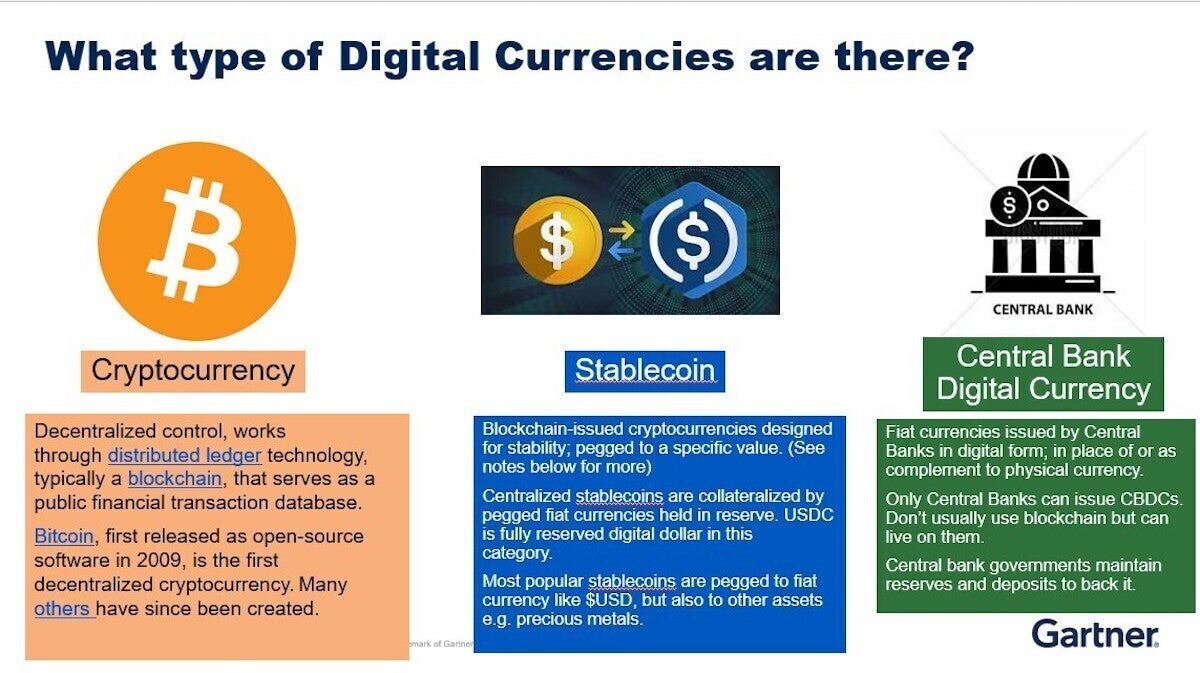
Even before President Joe Biden's Executive Order (EO) from the White House last week, the United States had been exploring the creation of a central bank digital currency (CBDC). But their efforts have lagged far behind other countries.
In the executive order, Biden called on various US agencies and regulators to step up their exploration of a digital form of the dollar, similar in some ways to cryptocurrencies such as bitcoin, but much more stable. Biden called on the Federal Reserve System (Fed) and other watchdogs to develop recommendations on how to close regulatory loopholes, mitigate economic risks, and respond to cryptocurrency-related cybersecurity issues.
Currently, however, the United States is playing catch-up with other countries that are already using or testing CBDCs or digital tokens. The consequences of another US overtaking could be serious.
“I think the United States has realized that it is far behind other countries, especially China, which is ahead technologically and politically,” Ananya Kumar, deputy director for digital currencies at the Atlantic Council Center for Geoeconomics, said in an email. Washington D.C.
“If we don't create our own, the standards will be set by other countries that are already realizing the benefits of this innovation, and the United States will be left behind,” Kumar said. "The EO has spoken very strongly in favor of American leadership on these issues. Until now, the United States has not focused its coordinated efforts on this."
Members of the Atlantic Council, a think tank, and US Treasury Secretary Janet Yellen testified before Congress last summer on the merits and challenges of CBDCs, which are faster, cheaper to administer and safer than cryptocurrencies, or even traditional cash.
"This is still a wild west spectacle and we need regulatory clarity to tame it," said Avivah Litan, a prominent analyst and vice president at research firm Gartner. "Regulatory agencies have different views on cryptocurrencies."
For example, the United States Securities and Exchange Commission (SEC), the Commodity Futures Trading Commission (CFTC), the Treasury, and the Internal Revenue Service (IRS) are not unified in their definitions and regulatory treatment. for cryptocurrencies, and the regulatory responsibilities and jurisdictions are clear between them (for example, through/between the CFTC and the SEC), Litan explained.
“There are also multiple competing efforts in Congress for cryptocurrency-related legislation, most of which have not passed,” Litan said. "Hopefully the executive order clarifies the roles and how cryptocurrencies are handled going forward."
Of the countries or regions with the four largest central banks - the United States, the European Union, Japan and the United Kingdom - the United States is the furthest behind, according to the Atlantic Council. And China has expanded the pilot program for its retail CBDC, e-CNY, while also banning the use of cryptocurrencies. Nigeria launched its CBDC, e-Naira, in October 2021 for retail use.
"China, Thailand, the United Arab Emirates and many other countries are also exploring cross-border projects, signaling their interest in setting international technological and political standards," Kumar said in a blog post last week.
One of the problems with the lack of international standards and regulatory oversight is that cryptocurrencies can be used by criminal groups for nefarious activities and rogue countries to bypass traditional financial messaging networks. For example, facing a growing number of sanctions following the invasion of Ukraine, Russia is likely using cryptocurrencies to conduct cross-border trade anonymously.
“For starters, you need privacy and consumer protection standards,” Kumar said. "Europe currently leads the world with this and anyone who wants to trade with them has to abide by these standards. It's a very fragmented system right now, and this is where you need international bodies to create standards that work in your favor."
Digital currency, including cryptocurrencies, has seen explosive growth in recent years, surpassing a market capitalization of €3 trillion last November (up from €14 billion five years earlier). Surveys suggest that around 16% of American adults, around 40 million people, have invested, traded or used cryptocurrencies. More than 100 countries are exploring or testing CBDC, a digital form of a country's sovereign currency.
Broadly speaking, there are three types of digital currency:
- Cryptocurrenciessuch as bitcoin and Ethereum, created and traded on blockchain distributed ledger technology (DLT);
- stable currencysuch as Tether and USD Coin, backed by fiat currencies such as the US dollar;
- Central bank digital currency (CBDC), or fiat currencies issued by central banks in digital form and are not classified as cryptocurrencies.
People who buy and sell digital currencies use digital wallets that contain public and private encryption keys. Public keys are used to send or receive digital currencies; private keys ensure that no one can steal it from the holder, because only they have the code. Digital currency transactions are recorded through an online electronic ledger which, in the case of CBDCs, is typically operated by a central bank. In contrast, cryptocurrencies, like bitcoin, are transferred and tracked on a public electronic ledger called a "blockchain," which is maintained by digital currency "miners," or people who use computers to generate cryptocurrency.
Cryptocurrencies offer anonymity to sellers and buyers through encryption, but that same encryption ensures that transactions are immutable or immutable.
However, some CBDC projects use blockchain distributed ledger technology (DLT), the same technology used by bitcoin and other public cryptocurrencies.
Sweden, for example, is testing a DLT blockchain for its digital currency, and these currencies can interact with other CBDCs. For example, the Chinese digital yuan can be transferred via a bridge, gateway, or other interoperability protocol to a DLT/Blockchain "as they did," Litan said.
 Gartner
Gartner
The three cryptocurrency typos.
Banks have already tried stablecoin as a cross-border payment method to augment or replace traditional financial rails, such as SWIFT, the world's largest financial messaging network.
JP Morgan and Wells Fargo tested their own stablecoin to handle internal deals with their trading partners. Unlike cross-border transactions through traditional settlement messaging networks, which can take three days or more to settle, cryptocurrency transactions are nearly instant and there are no fees.
Even before Biden's executive order, the United States was considering creating a federally backed digital dollar through the Hamilton Project, a collaboration between the Federal Reserve Bank of Boston and the Digital Currency Initiative (MIT DCI). ) from the Massachusetts Institute of Technology.
The goal of the Hamilton project is to create a CBDC design and gain a practical understanding of the technical challenges and opportunities. “Our primary goal was to design a core transaction processor that would meet the robust speed, performance, and fault tolerance requirements of a large retail payment system,” Hamilton's project brief states.
The Federal Reserve also recently published a CBDC guidance document; it is currently in the public comment stage until May 22.
 Gartner
GartnerToday, eighty-seven countries (representing more than 90% of global GDP) are exploring a CBDC with 45 central banks; as of May 2020, only 35 countries were considering a CBDC, according to the Atlantic Council.
Nine countries have already launched a digital currency. Nigeria is the latest with e-Naira, the first CBDC outside the Caribbean.
At the same time, 15 countries have launched CBDC pilots to test the waters, including China, Russia, Saudi Arabia and South Africa, Singapore, South Korea, and Thailand. “China is much further along than the United States and trialled a multinational distributed ledger for cross-border payments with Thailand, the United Arab Emirates and Hong Kong about a year ago,” Litan said.
In 2019, two of the largest economies in the Middle East, the United Arab Emirates and Saudi Arabia, launched a bilateral CBDC pilot called Project Aber. The project concluded that DLT can successfully facilitate cross-border transactions.
"The project successfully achieved its key objectives, which include the use of a new DLT-based solution for real-time cross-border interbank payments between commercial banks without the need to maintain and reconcile Nostro accounts with each other," a Multinational study concluded . "This promises to address the inefficiencies and costs inherent in existing cross-border payment mechanisms."
In February 2021, the United Arab Emirates joined China, Hong Kong, and Thailand in a joint cross-border trial of CBDCs. This “Multi-Central Bank Digital Currency Bridge (m-CBDC)” will test the use of DLT for foreign currency payments, the Atlantic Council said.
Without global standards and international coordination, however, any CBDC-based cross-border payment system could face significant interoperability issues in the future, according to the Atlantic Council.
Kumar said the United States had to move quickly if it wanted to catch up with what other nations had been doing.
“The United States has not focused its coordinated effort on this, and this is the time that we are starting to think about it more seriously than we have,” he said. "Otherwise, we will miss out on the applications of this innovation. We will miss out on the usefulness of this technology and how regulated innovations can bring financial benefits to our society. And we will miss out on cheaper and faster solutions." and more secure payments.
Copyright © 2022 IDG Communications, Inc.